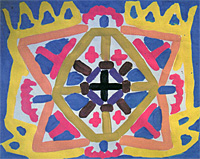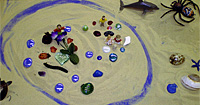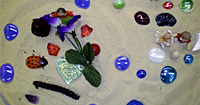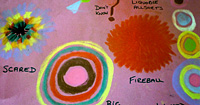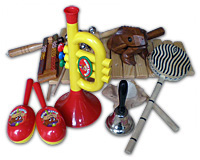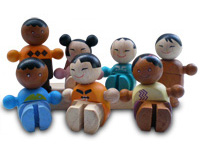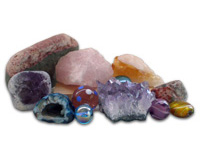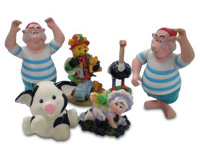Creative counseling involves the use of visual art materials with the client being actively engaged in the ark-making process and discussion about it. Various creative media is made available including- drawing, painting, writing, clay, movement, puppetry, sound, music, dance journaling and stories.
This lady was asked to create an experience of conflict...' she drew her face emphasising the physical tension she felt when experiencing a build up of stress... the right side of her face shows lightning streaks coming from her face denoting the powerfulness of the debilitation she experiences when stressed.
The circular drawing reveals how she would like things to be, bright, connected and feeling a sense of unity and calm.
A further conflict themed activity revealed an experience of internal conflict she felt deep inside... black parts representing chaotic feelings, orange and yellow signifying light and brightness demonstrating the optimistic part of her character.
In this picture she created a collage of a conflict situation, four squares being family members.
This was painted by a young man feeling distressed at a time of grieving for his bereaved friend.
This sandtray creation was created by a middle aged lady who has depicted a current conflict situation around family. she has created an island of safety, placing figurine statues of her children in the middle, the person creating the conflict is buried beneath the sand. The shark is protecting the family by waiting in a position to strike should there be further conflict.
The daughter figurine is surrounded by a buddha object symbolic of her need for peace, green crystal heart is placed closed to hershowering her with love, the black caterpillar is symbolic of a mother figure, close enough to support her.
The mandala picture represents the array of emotions felt by the mother
Creative Mediums Used
Clay: Stimulates tactile senses allowing individuals to get in touch with blocked sensory or emotional experiences. A range of painful emotions are likely to emerge and be expressed through this activity, from serenely stroking and smoothing the clay to aggressively poking, punching or pulling it apart.
Masks: can be used as a protective device, giving you a voice, enabling you to take on a different persona giving you the opportunity to become whatever you want. You can hide, speak out, challenge injustices with engagement of the medium promoting a sense of empowerment and increased sense of self esteem.
Sandtray: is used to encourage non verbal expression using symbols and miniature animals/objects. The symbolic meaning can then be explored through the representation, arrangement and relationship to each other whilst placed and maneourvered in the sand. The ideas can then be put into language. It helps individuals to gain mastery over past and present events. Exploring themes and issues related to those events through the use of symbols and miniatures. Touching the miniature objects and placing them in the sand helps individuals to create role played dialogue, talking on behalf of the person the symbol represents.
Art: can help individuals understand current and past issues, exploring and expressing emotions. Painiting and drawing enables individuals to communicate and express feelings that might otherwise be difficult to articulate.
Every symbol and image holding a special meaning for each child/individual in their chosen language.
Story: Altering and telling stories invites children to encounter, re-examine events and characters that are needed to resolve problems. Children and adults can express their hopes, fears, anxieties in a story, acting them out through language of metaphor. In the safety of their magical and make believe worlds they can project aspects of themselves onto others through relating to characters helping them to reframe their personal experiences and explore their identity and troubled worlds.
Writing and drama activities associated with themes of loss, bereavement and abuse through storymaking are explored.
Puppetry: invite children to create, communicate and project their own ideas, behaviours, personalities, and words into the mouths of the puppet characters. They can then manipulate, promote conversation, express fantasies to explore troublesome emotions or conflict situations. It is the puppet that talks or is questioned not the person with children becoming more vocal through the puppet.
Dance: Through Dance and movement therapy a person can engage creatively in a process to further emotional, cognitive, physical and social integration, discovering a whole new range of possibilities within your body. You can symbolize conflicts giving new meaning to your inner world . The use of expressive movement and dance acts as a vehicle through which an individual can engage in the process of personal integration, growth, motion and emotion.
Creative Writing: Through journaling, poetry, and creative writing feelings can be transformed, helping to integrate felt experiences within our body and minds linking up realizations about what is going on inside us. It offers a means of organizing chaotic thoughts into a formal shape.
It provides an opportunity to externalize feelings, develop self esteem and develop concentration.
The approach in indirect and non threatening intended for therapeutic use within the mental health field.
Play: can be used as a safety valve through which repressed or socially unacceptable emotions can find expression. Play reduces anxiety and can be used as a means for coping with emotional stress. Play is not only confined to childhood but is also engaged in by adults. A childís natural instinct is to interplay with objects through touch, sight, and voice. Using these experiences the child acquires tools for communication upon which patterns in his/her life are based.
Mandalas: helps individuals draw on the unconscious reservoirs of strength- making a personal symbol reveals who we are at that moment. The circle we draw contains parts of ourselves, surfaces hidden conflicts, and releases hidden tensions.Meditating with mandalas can serve as a centering device bringing clarity out of chaos and confusion.
Some issues that creative counseling might help with are:
- Relationship breakdown and communication difficulties
- Separation, divorce, loss, grief or bereavement
- Children living with addiction or domestic violence
- Behavioral difficulties, aggressive, withdrawn, defiant or controlling individuals
- Children who have experienced abandonment and are in residential or foster care
- Insecurities, fears and bullying
- Depression
- Self harm
- Anxieties, stressors and panic
- Issues of sexual, emotional, racial or physical abuse
Creative therapy and play therapy sessions
As an integrative creative counselor I help clients to understand and alleviate emotional distress, promoting self development bringing emotional balance.
Individual counselling sessions £42.00 per hour
Individual Therapeutic work Child Therapy
Adults: A 50 minute individual counseling session
Child: A 50 minute play therapy/ emotional release counseling session (see emotional release counselling/ play therapy and creative therapy)
Creative therapy toolkit
Various creative media is provided by the use of a creative therapy toolkit




